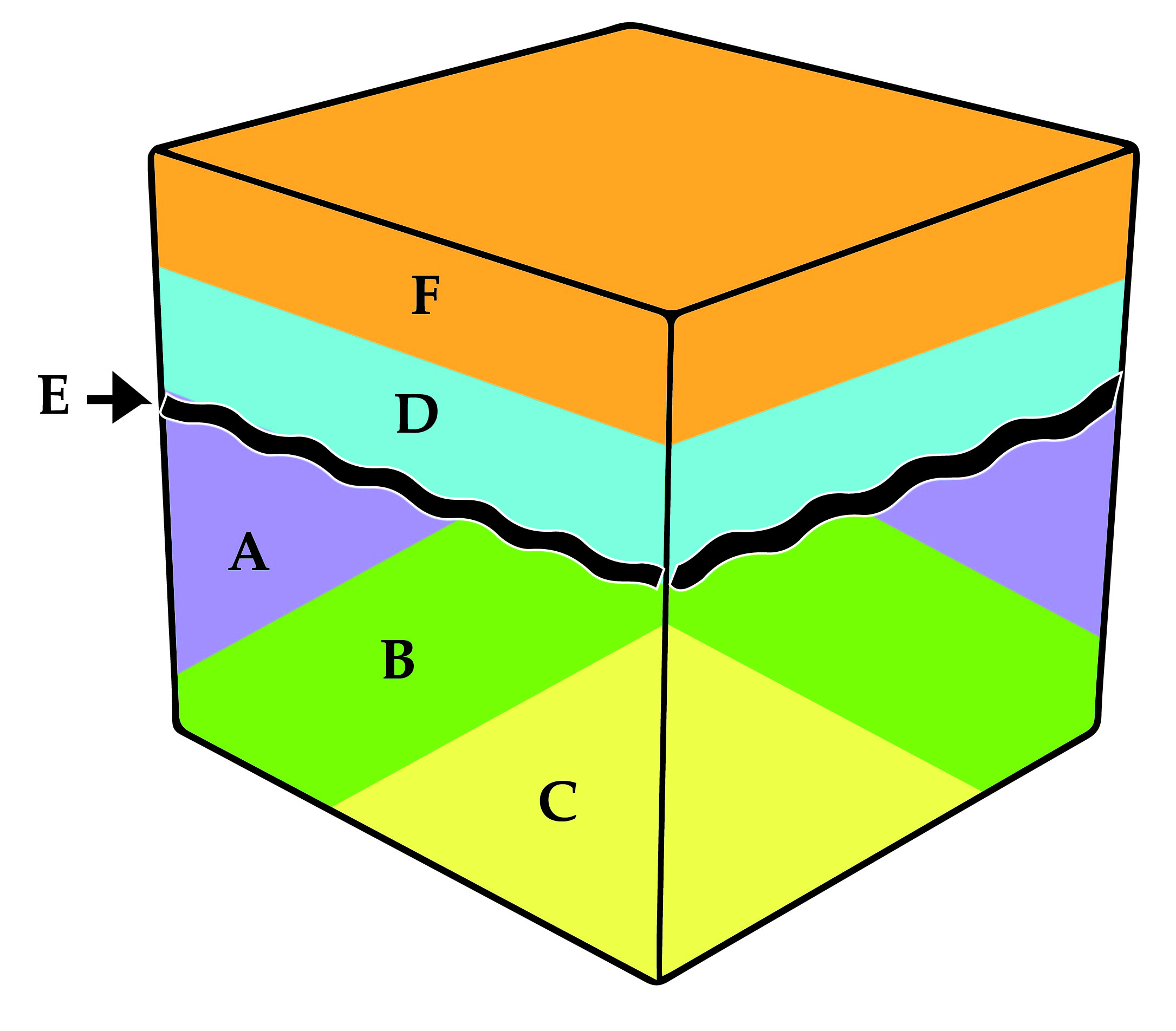What natural disaster is caused directly by plate tectonics?
Earthquakes
Conserving our natural resources is one of the challenging issues of the 21st century. What important natural resource is comprised of clay, silt, pebbles, and sand?
A. Coal
B. Soil
C. Fossil fuels
D. Iron
B. Soil
A volcano that has not erupted for a long time, but may erupt again one day.
A. Active volcano
B. Dormant volcano
C. Extinct volcano
D. Shield volcano
B. Dormant volcano
Geological time scales are used to measure spans of time. In terms of geological time scales, which category represents the longest length of time?
A. Period
B. Epoch
C. Era
D. Age
C. Era
Which of the following factors can cause a sedimentary rock to change into a metamorphic rock?
A. Addition of fluids
B. Increasing pressure
C. Increasing temperature
D. All of these
D. All of these
A __________ plate boundary forms when two tectonic plates move together, the higher density plate subducting under the other.
A. transform
B. strike-slip
C. divergent
D. convergent
D. Convergent
__________ is soil with the smallest particles. (Less than 0.002mm diameter).
A. Silt
B. Loam
C. Sand
D. Clay
D. Clay
A researcher studies the natural history of volcanoes. He has found that a volcano in South America was formed by plates that collided and slid under each other. What type of volcano has the researcher discovered?
A. Subduction Volcano
B. Extinct Volcano
C. Dormant Volcano
D. Rift Volcano
E. Active Volcano
A. Subduction Volcano
Geological time scales are used to measure spans of time. In terms of geological time scales, which category represents the smallest length of time?
A. Supereon
B. Eon
C. Era
D. Period
D. Period
Which of the following rock types is a result of the rapid cooling of magma?
A. Igneous
B. Fossilized
C. Oceanic
D. Sedimentary
E. Metamorphic
A. Igneous
The theory of plate tectonics describes the movement of tectonic plates within Earth's __________.
A. Outer Core
B. Lithosphere
C. Asthenosphere
D. Inner Core
B. Lithosphere
Which element is not a component of soil?
A. Mineral material
B. Partially decomposed organic matter
C. None of these
D. Living organisms
C. None of these
Which of the following pairs of terms best identifies the two types of igneous rock?
A. Lava, ash
B. Metamorphic, volcanic
C. Plutonic, mafic
D. Intrusive, extrusive
D. Intrusive, extrusive
The seasons experienced on Earth are caused by __________.
A. The elliptical shape of Earth's orbit around the sun
B. The varying temperature of the sun during different times of year
C. The proximity of the Earth to certain star clusters at moments during the Earth's orbit around the sun
D. Geothermal energy on a biological clock
E. The 23.5∘ tilt of the Earth's axis
E. The 23.5 tilt of the Earth's axis
Which of the following statements about the rock cycle is not true?
A. Sedimentary rock can become metamorphic rock or igneous rock.
B. Igneous rock can form from either sedimentary or metamorphic rock.
C. Sedimentary rock can become metamorphic rock, but not igneous rock.
D. Metamorphic rock can become sedimentary rock or igneous rock.
C. Sedimentary rock can become metamorphic rock, but not igneous rock.
We can calculate the magnitude of an earthquake because earthquakes release energy that create _________.
A. Capillary Waves
B. Seismic Waves
C. Heat Waves
D. Chop waves
B. Seismic Waves
What are soil horizons?
A. The materials that make up the soil
B. The chemical properties of the soil
C. The physical properties of the soil
D. The result of human disturbances
E. The horizontal layers of soils
E. The horizontal layers of soils
Any substance emitted by an active volcano
A. Ejecta
B. Ash
C. Magma
D. Lava
A. Ejecta
Which of the following best explains the difference between weathering and erosion?
A. Weathering is the chemical process that creates sediment, while erosion is the physical process of creating sediment
B. Weathering is the physical process that creates sediment, while erosion is the chemical process of creating sediment
C. Erosion is the process that creates sediment, while weathering is the process of transporting sediment
D. Weathering is the process that creates sediment, while erosion is the process of transporting sediment
D. Weathering is the process that creates sediment, while erosion is the process of transporting sediment
A stream with lots of pebbles of various shapes and sizes is buried. What type of rock will be created when these pebbles are lithified?
A. Metamorphic
B. None of these
C. Igneous
D. Sedimentary
D. Sedimentary
Why does one plate not sink below the other when two continental plates converge?
The plates have the same density
What is the brown insoluble particles from partially decomposed organic matter?
A. Clay
B. Minerals
C. Waterlog
D. Rill
E. Humus
E. Humus
Both the Hawaiian and Galapagos Islands are formed from what type of volcanoes?
A. Subduction Volcanoes
B. Composite Cones
C. Hot Spot Volcanoes
D. Rift Volcanoes
E. None of these
C. Hot spot volcanoes

Examine the given block diagram. Each letter represents a depositional event or a period of erosion. Place the letters in order from the oldest to youngest event.
C, B, A, E, D, F
A sedimentary rock is buried deep within the earth. At a certain depth, the rock melts completely and recrystallizes. Which of the following best identifies what type of rock is formed post recrystallization?
A. Conglomerate
B. Igneous
C. Metamorphic
D. Sedimentary
B. Igneous